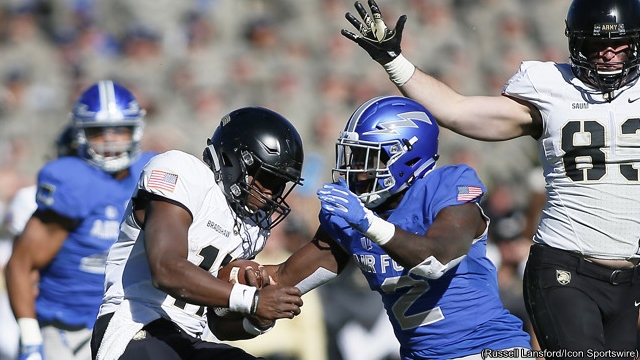
A very quick look at Air Force’s 2019 football schedule makes it plain: The Falcons have to be on top of their game early in the season.
Colorado, Boise State, Navy, Fresno State. Those four games will have a lot to say about the direction — and outcome — of the Falcons’ season.
The Colorado game is the game the Falcons ought to win. If they win that one, they can enter the Boise-Navy-Fresno gauntlet with confidence and belief.
Boise State is significant for Mountain West Mountain Division positioning. A win there would give the Falcons a reasonable chance at a division title. They would be able to stay in the hunt into November (at the very least) if they can buck the Broncos.
Navy is a Commander In Chief’s Trophy game, whose value needs no explanation. Air Force (like Navy) is trying to stop Army from winning a third straight CIC Trophy this year.
Fresno State, the defending Mountain West champion, gives Air Force a chance to see how much it has evolved. If the Falcons lose to Boise State, they can play Fresno State in order to reset their Mountain West season. A win over Fresno would send Air Force into the second half of its season with the knowledge that it can beat any of the remaining MWC teams on the schedule.
Air Force would be really happy to go 2-2 in these four games, all things considered. The Falcons have to go at least 1-3 against this rough portion of the schedule. They can’t go 0-4. That would be a disaster, putting them in jeopardy of missing a bowl game for the third straight season.
A discussion of this four-game sequence takes on added urgency precisely because these games occur early in the season, rather than late. The timing of various games is often (though certainly not always) a relevant factor in college football. Some teams and programs start slowly and roar in late October or early November. Some programs are better at starting quickly and then fade in the second half of the season.
The challenge for a lot of teams in September is to get consistent, reliable performances from the offense. Everyone needs to be on the same page. Quarterbacks and receivers need to develop a rapport. Sloppy September football is the rule, not the exception. Being ready to pounce on an opponent’s sluggish early-season performances can become the difference between a 5-7 season and a 7-5 year.
Enter the Air Force defense, which was a very solid scoring defense a year ago — allowing an average score in the mid-20s — but fell short in another key area: forced turnovers.
The numbers stand out because of how small they are: Air Force created only 14 takeaways last year, seven recovered fumbles and seven passes picked off.
The seven recovered fumbles put AFA outside the top 80 in the FBS. The Falcons tied with several teams for 81st on that list.
The seven passes intercepted — in a sport which has become more pass-centric this century — naturally figured to put Air Force even lower on the list… and that’s true. Whereas seven recovered fumbles placed Air Force at 81, seven INTs put Air Force’s defense in a tie for 101st in the FBS.
81st in fumbles recovered, 101st in interceptions. Air Force’s defense wasn’t the sieve it was in 2017, but the lack of takeaways was still a problem.
The takeaways need to add up in this four-game sequence in the first half of the season.
Colorado has a highly vulnerable offense. Air Force’s defense might be able to feast against the Buffaloes… but as said above, that is the game in this stretch the Falcons are supposed to win.
The really interesting games are the ones against Boise State and Navy.
Boise State has been quarterbacked by Brett Rypien the past few seasons. The Broncos will have a new signal-caller this season and have a very uncertain quarterback situation. Drawing Boise State early in the season is a real opportunity for Air Force, given the lack of a proven Boise State quarterback. That is a game in which Air Force can create a realistic path to victory with three picks. Boise State will be favored to win that contest, but the Air Force defense will have a realistic chance to make a statement.
The Navy game figures to be a challenge for Air Force, even though the Falcons won handily last season against a Navy team which fell to 3-9. Air Force bullied Navy a year ago. Navy’s offensive line had what was its worst season this decade under Ken Niumatalolo.
The chances of Navy’s O-line playing that poorly this year are low. The Midshipmen have a lot to prove. Moreover, the last six AFA-Navy games have been split, with the home team winning each time. This year’s game is in Annapolis. Air Force can’t expect Navy’s offense to struggle the way it did last season.
Taking the ball away figures to be very important against the Midshipmen.
Fresno State, the fourth and final team in this brutal first-half gauntlet in the 2019 season, is a smashmouth team. Jeff Tedford likes his offense to be balanced and physical. Tedford wants defenses to account for the full width of the field and to constantly guess between run and pass.
Air Force could get worn down by Fresno State’s offensive attack. The antidote: Take the ball away. Would it be great if Air Force can come up huge on third downs? Sure… but Fresno State figures to have a very good team. Expecting a bunch of three-and-outs against the Bulldogs might not be supremely realistic. Takeaways offer the gateway to victory for Air Force in that clash.
81st in recovered fumbles, 101st in picks. Air Force can’t have those national FBS rankings in 2019. At the very least, if Air Force can’t take away the ball in the more manageable second half of its 2019 schedule, the Falcons will have to collect a lot of turnovers against Colorado, Boise State, Navy, and Fresno State.



